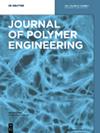纤维素衍生物对聚(3-羟基丁酸-3-羟基戊酸)结晶和机械性能的影响
IF 1.7
4区 工程技术
Q4 POLYMER SCIENCE
引用次数: 0
摘要
本研究用纤维素衍生物对聚(3-羟基丁酸-3-羟基戊酸)(PHBV)进行改性,并研究了不同种类的纤维素衍生物对 PHBV 结晶和力学性能的影响。通过差示扫描量热仪、偏光显微镜和力学性能测试仪器测量了 PHBV/纤维素衍生物复合材料的结晶和力学性能。研究表明,醋酸纤维素(CA)能促进 PHBV 的结晶,少量的 CA 就能显著提高 PHBV 的结晶温度。CA 还能加快 PHBV 的结晶速度。然而,醋酸纤维素丙酸酯(CAP)和醋酸纤维素丁酸酯(CAB)的加入降低了 PHBV 的结晶温度,抑制了 PHBV 的成核。抑制程度随 CAB 和 CAP 含量的增加而增加。CAB 和 CAP 与 PHBV 具有良好的相容性,CAB 和 CAP 可以均匀地分散在 PHBV 中。特定组分含量的纤维素衍生物可增强 PHBV 的拉伸性能而不损失冲击强度。本文章由计算机程序翻译,如有差异,请以英文原文为准。
Effect of cellulose derivatives on crystallization and mechanical properties of poly(3-hydroxybutyrate-co-3-hydroxyvalerate)
In this work, poly(3-hydroxybutyrate-co -3-hydroxyvalerate) (PHBV) was modified by cellulose derivatives, and the effects of different kinds of cellulose derivatives on the crystallization and mechanical properties of PHBV were investigated. The crystallization and mechanical properties of PHBV/cellulose derivatives composites were measured by means of differential scanning calorimeter, polarizing microscope, and mechanical properties testing instruments. Studies show that cellulose acetate (CA) can promote the crystallization of PHBV, a small amount of CA can significantly increase the crystallization temperature of PHBV. The crystallization rate of PHBV was also accelerated by CA. However, the addition of cellulose acetate propionate (CAP) and cellulose acetate butyrate (CAB) decreased the crystallization temperature of PHBV and inhibited the nucleation of PHBV. And the degree of inhibition increased with the increase of CAB and CAP content. CAB and CAP have good compatibility with PHBV, CAB, and CAP can be uniformly dispersed in PHBV. Cellulose derivatives with specific component content can enhance the tensile properties of PHBV without losing the impact strength.
求助全文
通过发布文献求助,成功后即可免费获取论文全文。
去求助
来源期刊

Journal of Polymer Engineering
工程技术-高分子科学
CiteScore
3.20
自引率
5.00%
发文量
95
审稿时长
2.5 months
期刊介绍:
Journal of Polymer Engineering publishes reviews, original basic and applied research contributions as well as recent technological developments in polymer engineering. Polymer engineering is a strongly interdisciplinary field and papers published by the journal may span areas such as polymer physics, polymer processing and engineering of polymer-based materials and their applications. The editors and the publisher are committed to high quality standards and rapid handling of the peer review and publication processes.
 求助内容:
求助内容: 应助结果提醒方式:
应助结果提醒方式:


